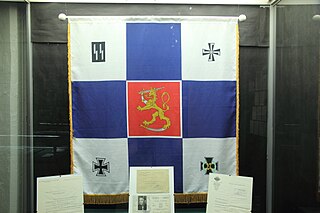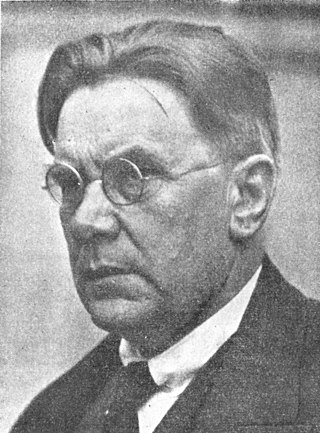Related Research Articles

Rolf Herman Nevanlinna was a Finnish mathematician who made significant contributions to complex analysis.

Lauri Allan Törni, later known as Larry Alan Thorne, was a Finnish-born soldier who fought under three flags: as a Finnish Army officer in the Winter War and the Continuation War ultimately gaining a rank of captain; as a Waffen-SS captain of the Finnish Volunteer Battalion of the Waffen-SS when he fought the Red Army on the Eastern Front in World War II; and as a United States Army Major when he served in the U.S. Army Special Forces in the Vietnam War.

From 1941 to 1943, 1,408 Finns volunteered for service on the Eastern Front of World War II in the Waffen-SS, in units of the SS Division Wiking. Most of these volunteers served as motorized infantry in the Finnish Volunteer Battalion of the Waffen-SS. The unit was disbanded in mid-1943 as the volunteers' two-year commitment had expired and the Finnish government was unwilling to allow more men to volunteer. In 1944-1945 a company sized unit of Finnish defectors recruited to the SS continued fighting alongside Germany.
Einsatzkommando Finnland was a German paramilitary unit active in northern Finland and northern Norway during World War II, while Finland was fighting against the Soviet Union with the support of Nazi Germany. The official name of the unit was Einsatzkommando der Sicherheitspolizei und des SD beim AOK Norwegen, Befehlsstelle Finnland, but it was often referred to as Einsatzkommando Finnland.

Karl Fredrik Kares was a Finnish Lutheran Vicar of Lapua and politician. He was a member of the Parliament of Finland, representing the Finnish Party from 1907 to 1910, the National Coalition Party from 1922 to 1927 and the Patriotic People's Movement (IKL) from 1933 until his death in 1942.

In Finland, the far right was strongest in 1920–1940 when the Academic Karelia Society, Lapua Movement, Patriotic People's Movement (IKL) and Export Peace operated in the country and had hundreds of thousands of members. In addition to these dominant far-right and fascist organizations, smaller Nazi parties operated as well.
The National Socialist Union of Finland, later the Finnish-Socialist Party was a Finnish Nazi political party active in the 1930s, whose driving force and ideologue was Professor Yrjö Ruutu. With an ideology based on Ruutu's theories, the party came to reject orthodox German Nazism.
The Finnish National Socialist Labor Organisation was a Finnish Nazi party led by Teo Snellman. The movement that operated during the armistice and the Continuation War was also known as the National Reform Labor Organization (KUT) and the Finnish National Socialist Workers' Party (SKTP). The party's organ was Vapaa Suomi, which appeared between 1940 and 1944.

The Finnish People's Organisation was a bilingual Nazi party founded by Jaeger Captain Arvi Kalsta. Supporters of the movement were also called Kalstaites after the leader. The inaugural meeting of the organization was held in March 1933 and was attended by about 500 members. SKJ published the magazines Herää Suomi, Hakkorset and Hakaristi. In addition to its own magazines, the organization had its own publishing house Vasara. The organization wore a brown uniform like the Sturmabteilung of the German Nazi Party, and used the greeting "Finland Awake!"
Rising Finland was a Finnish political association founded on October 5, 1940. It aimed to "nurture the Spirit of the Winter War", promote the idea of a united people, to reorganize the bourgeois party field and to create a stronger leadership and increasing personal responsibility. According to the organization, its goal was to bring together citizens around national symbols whose value was "perceived by all our people in the great trials of the 1939-1940 War of Independence".

Martti Aleksander Pihkala was a National Coalition Party MP who became known as a Jäger activist, Ostrobothnia White Guard founder, in the 1920s and 1930s, leader of the strikebreaking organisation Export Peace, also known as "Pihkala's Guard" and an influencer of the Lapua movement and the Patriotic People's Movement.

Johan Christian Sergei Fabritius was a Finnish military lieutenant colonel.

Petter Teodor Forsström was a Finnish industrialist, Vuorineuvos and the father of the Lohja lime industry. Forsström worked as Lohjan Kalkkitehdas Oy's managing director for an exceptionally long period of time, 65 years. In 1946 he was sentenced to prison for treason after participating in the Pro-German resistance movement in the late stages of the Continuation War and during the Lapland War.

Vietti Brynolf Nykänen was a Finnish architect, writer and politician.
The Pro-German resistance movement in Finland was set up during the latter stages of the Second World War after the Moscow Armistice by Nazi Germany and the extreme right in Finland, who prepared for armed struggle against the expected Soviet occupation. Germany funded the activities and provided the necessary training. The project was separate from the plans drawn up by Finnish chief of staff officers in the summer of 1944 for the transition to guerrilla warfare. When there was no occupation, propaganda and smuggling hundreds of people out of Finland became the principal activity of the organization. After the defeat of Germany, the movement did not disintegrate but operated in Finland for several more years. Some members of the movement were caught, and 11 were convicted of treason in 1946.
Thoralf Kyrre was a Danish engineer who was involved in the Pro-German resistance movement in Finland from 1944 to 1945.
Niilo Vilho Rauvala was a Finnish engineer and the chairman of the far-right Lalli Alliance of Finland and the Nazi Party of Finnish Labor in the 1930s and 1940s.
The Lalli Alliance of Finland was a Finnish far-right organization founded in 1929. The main themes of the Lalli Alliance were Finnish language nationalism and opposition to communism, parliamentarism and democracy. The aim of the organization was a coup and the appointment of a dictator to lead Finland. The most significant achievement of the organization is considered to be that the Lalli Alliance has been considered to have acted as a precursor to the Lapua movement.
Frans Johannes Leino was a Finnish lawyer and Social Democrat Member of Parliament.
Front Soldier League was a Finnish civil war White Guard veteran organization between the years 1929 and 1944, which also had extreme right-wing political objectives. In the early 1930s, it had close links with the Lapua movement, in which the leaders of the League played an important role. The Front Soldier League was abolished in 1944 on the basis of the Moscow peace treaty, which forbade fascist organizations. It had a sister organization for women, the Front Soldier Women's League, which was also disbanded.
References
- ↑ Pohjonen, Juha; Silvennoinen, Oula (2013). Tuntematon Lauri Törni[Unknown Lauri Törni] (in Finnish).
- ↑ Pilke, Antti (20 October 2013). "Historioitsija: Lauri Törni sekaantui natsikumouksen ajamiseen Suomeen [Historian: Larry Thorne was involved in Nazism in Finland]". Uutiset (in Finnish). Yle.
- ↑ Lehto, Olli (2001). Korkeat maailmat : Rolf Nevanlinnan elämä. Otava. p. 154–157. ISBN 951-11720-0-X.
- 1 2 Ekberg, Henrik. "Suomen valtakunnan liitto". Uppslagsverket Finland.
